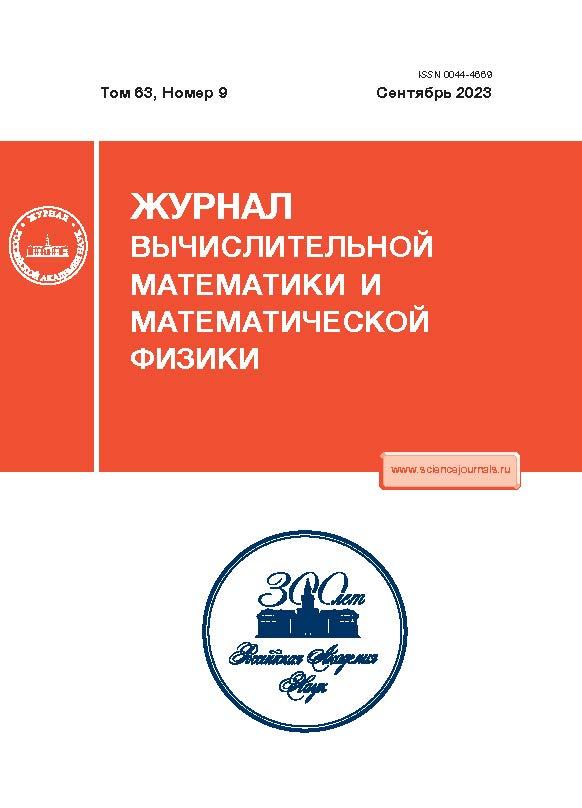Constructive Algorithm to Vectorize P ⊗ P Product for Symmetric Matrix P
- 作者: Glushchenko A.I.1, Lastochkin K.A.1
-
隶属关系:
- V.A. Trapeznikov Institute of Control Sciences of RAS
- 期: 卷 63, 编号 9 (2023)
- 页面: 1415-1427
- 栏目: General numerical methods
- URL: https://ruspoj.com/0044-4669/article/view/664977
- DOI: https://doi.org/10.31857/S0044466923090090
- EDN: https://elibrary.ru/ROMVVI
- ID: 664977
如何引用文章
详细
A constructive algorithm to compute elimination L and duplication D matrices for the operation of P ⊗ P vectorization when P = PT is proposed. The matrix L, obtained according to such algorithm, allows one to form a vector that contains only unique elements of the mentioned Kronecker product. In its turn, the matrix D is for the inverse transformation. A software implementation of the procedure to compute the matrices L and D is developed. On the basis of the mentioned results, a new operation vecu(.) is defined for P ⊗ P in case P = PT and its properties are studied. The difference and advantages of the developed operation in comparison with the known ones vec(.) and vech(.) vecd(.)) in case of vectorization of P ⊗ P when P = PT are demonstrated. Using parameterization of the algebraic Riccati equation as an example, the efficiency of the operation vecu (.) to reduce overparameterization of the unknown parameter identification problem is shown.
作者简介
A. Glushchenko
V.A. Trapeznikov Institute of Control Sciences of RAS
Email: aiglush@ipu.ru
117997, Moscow, Russia
K. Lastochkin
V.A. Trapeznikov Institute of Control Sciences of RAS
编辑信件的主要联系方式.
Email: lastconst@ipu.ru
117997, Moscow, Russia
参考
- Magnus J.R., Neudecker H. The elimination matrix: some lemmas and applications // SIAM Journal on Algebraic Discrete Methods. 1980. V. 1 (4). P. 422–449.
- Nagakura D. On the relationship between the matrix operators, vech and vecd // Communications in Statistics-Theory and Methods. 2018. V. 47(13). P. 3252–3268.
- Sastry S., Bodson M. Adaptive control: stability, convergence and robustness. Courier Corporation, 2011.
- Lavretsky E., Wise K.A. Robust adaptive control // Robust and adaptive control. London: Springer, 2013.
- Ioannou P.A., Sun J. Robust adaptive control. Courier Corporation, 2012.
- Ortega R., Nikiforov V., Gerasimov D. On modified parameter estimators for identification and adaptive control. A unified framework and some new schemes // Annual Reviews in Control. 2020. V. 50. P. 278–293.
- Lion P.M. Rapid identification of linear and nonlinear systems // AIAA Journal. 1967. V. 5. P. 1835–1842.
- Kreisselmeier G. Adaptive observers with exponential rate of convergence // IEEE Transactions on Automatic Control. 1977. V. 22 (1). P. 2–8.
- Aranovskiy S. Parameter Estimation with Enhanced Performance. Habilitation. Rennes: Université de Rennes 1, 2021.
- Lewis F., Syrmos V. Optimal control. John Wiley & sons, INC., 2nd edition, 1995.
- Kalman R.E. et al. Contributions to the theory of optimal control // Bol. Soc. Mat. Mexicana. 1960. V. 5 (2). P. 102–119.
- Polyak B.T., Shcherbakov P.S. Hard Problems in Linear Control Theory: Possible Approaches to Solution // Automation and Remote Control. 2005. V. 66(5). P. 681–718.
- Jha S.K., Roy S.B., Bhasin S. Data-driven adaptive LQR for completely unknown LTI systems // IFAC-Pa-persOnLine. 2017. V. 50 (1). P. 4156–4161.
- Jiang Y., Jiang Z.P. Computational adaptive optimal control for continuous-time linear systems with completely unknown dynamics // Automatica. 2012. V. 48 (10). P. 2699–2704.












